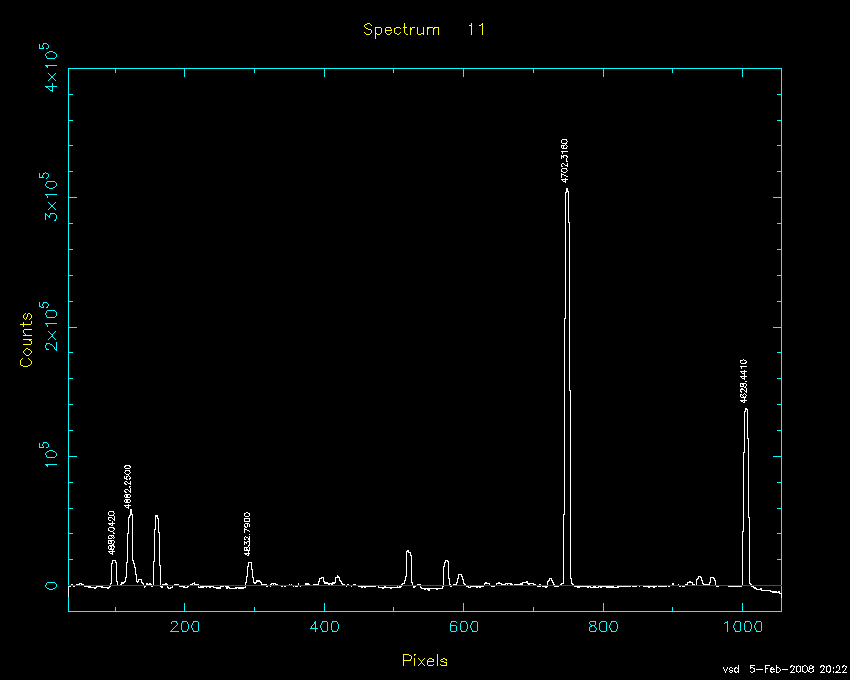
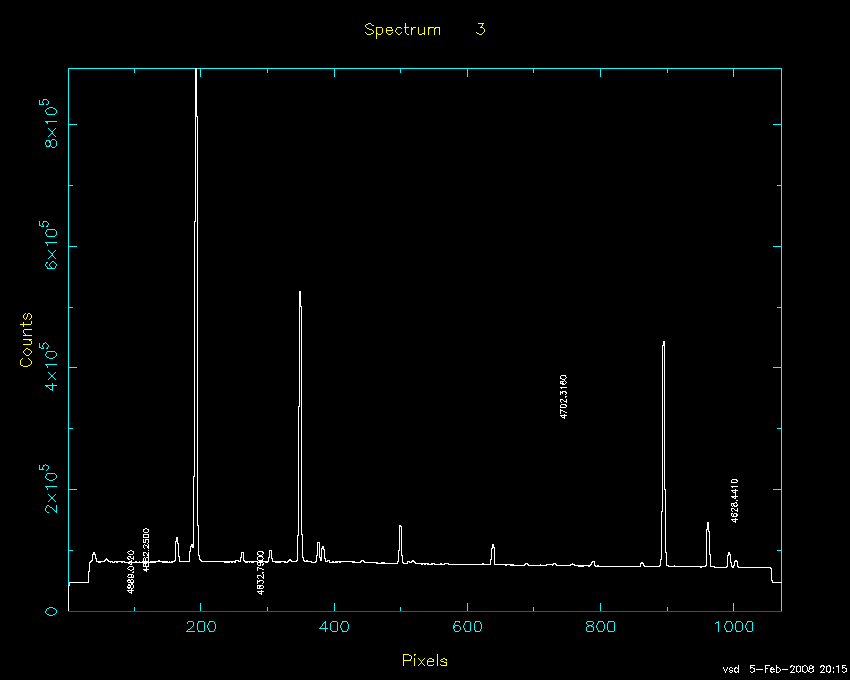
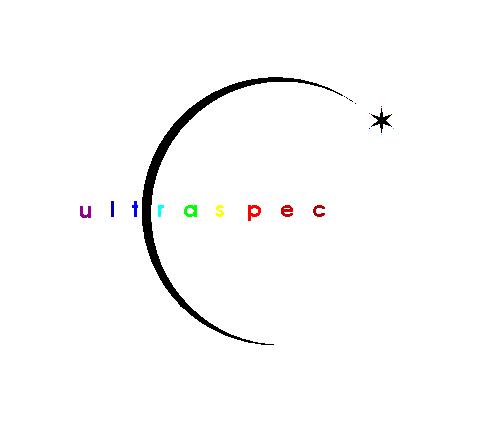
This document presents a brief report on the commissioning of the two volume-phase holographic grisms (VPHGs) procured for the ULTRASPEC run on EFOSC2 in January-February 2008. A document describing their specifications can be found here.
The VPH 475 (top) and VPH 656 (bottom) arc spectra shown below were obtained with an argon lamp and a 0.5" slit.


The wavelength range, central wavelength and dispersion of each VPH grism is given below:
The resolution, as calculated by measuring the FWHM of the arc lines in an argon arc spectrum taken with a 0.5" and 1.0" slit, is given for each VPH grism below:
It can be seen that the dispersions are slightly better than predicted. This can be thought of as an improvement upon the specifications, as I originally asked Kaiser Optical to design VPH grisms which can provide the maximum possible resolution given the space constraints of the EFOSC2 grism wheel. The slightly higher than expected dispersions result in slightly smaller wavelength ranges than predicted, but one which is still large enough to place both Hbeta and HeII 4686A on the ULTRASPEC chip (with the VPH 475 grism), for example. The central wavelengths of the two grisms are slightly larger than predicted, but the difference (of +50 ULTRASPEC pixels) can mostly be accounted for by the fact that the centre of the ULTRASPEC chip and the rotator centre are offset from each other in the dispersion direction by approximately 30 pixels, i.e. the centre of ULTRASPEC's chip is not perfectly aligned with the centre of the cryostat. None of the above are likely to be issues with ESO's CCD#40.
Observations of the Hamuy et al. (1994) spectrophotometric standard star LTT 3864 were made on the night of 2008 January 28. The star is of spectral class F with a magnitude B=12.17. All exposure times were of length 100 seconds and taken with a wide slit (10"). The seeing was approximately 1 arcsecond and the night was photometric. The normal output of the EMCCD was used and no settings were changed during the sequence of exposures. The above setup ensures that all differences observed in the spectra below are due to the different grisms used, and nothing else.
The figure below shows the spectrum of LTT 3864 taken with the new VPH 475 grism and the nearest equivalent in the ESO grism set - grism #3. Note that by "nearest equivalent", I mean the highest resolution ESO grism which overlaps in spectral range with VPH 475. In other words, slightly higher resolution ESO grisms are available, but they do not overlap in wavelength range with VPH 475 on the small ULTRASPEC chip.
The lower spectrum shows the spectrum taken with VPH 475 (run080),
the upper with grism #3 (run081). The data were reduced in exactly the
same way, and no offsets have been applied to the spectra in the
plot. Hence it is possible to directly compare the efficiencies of the
two grisms by measuring the counts obtained at the same wavelength,
and then correcting for the different grism dispersions. The
absorption line at the extreme left of each spectrum is that of
Hbeta. If we select a region of the continuum immediately to the right
of this line, it can be seen that the ratio of the counts in the two
spectra is:
Grism #3/VPH 475 ~ 18000/5000 = 3.6
According to the EFOSC2 grisms page, the dispersion of grism #3 is 1.5
A/pixel. This is when used with the 15 micron pixels of CCD#40. With
ULTRASPEC's 13 micron pixels, the dispersion of grism #3 is hence 1.3
A/pixel. The dispersion of VPH 475 is 0.29 A/pixel. Hence if the two
grisms are of equal efficiency, one would expect a ratio of counts of
1.3/0.287 = 4.5. (Note that no correction is necessary for the spatial
direction as the entire spatial extent of each spectrum was included
in the extraction). We observe a ratio of 3.6, hence we can conclude
that VPH 475 is 1.25 times more efficient than grism #3. According to
the plots on the EFOSC2 grisms page, the efficiency of grism #3 is
approximately 25% at the wavelength of Hbeta (4861 A).
Hence we can conclude that the efficiency of VPH 475 is approximately
30%.
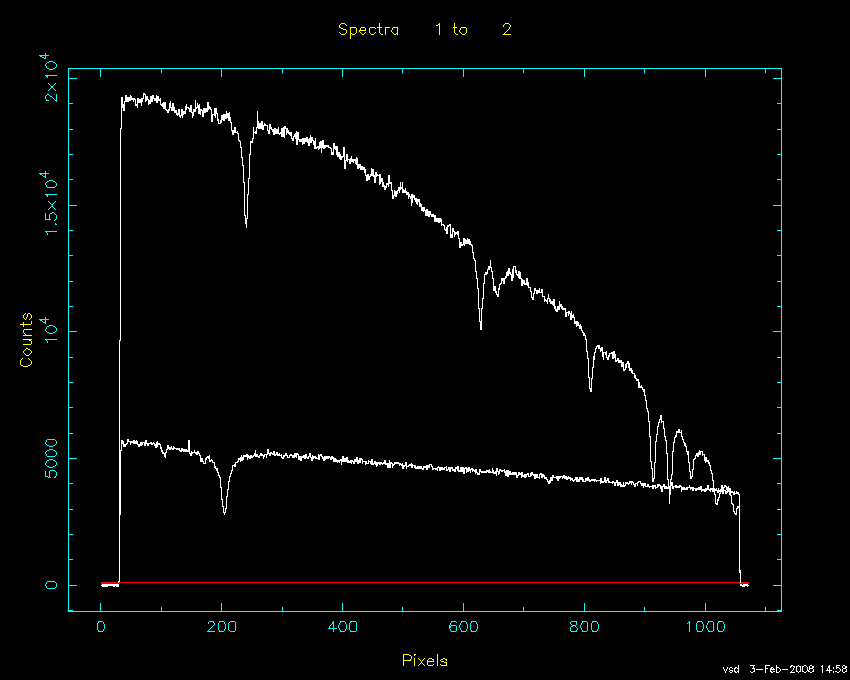
What would we have expected? The theoretical efficiency of the grating at this wavelength is 95%, but this is attenuated by absorption in the prism glass. As discussed in the specifications document, we were forced to use the highest refractive index glass currently available in the Schott catalogue in order to obtain the desired resolutions for VPH 475 and VPH 656, given the tight space constraints on the length of EFOSC2 grisms. The document shows that 10mm of this glass, N-SF66, has a transmission of approximately 90%. Taking the pessimistic assumption that the average light ray passes through 40mm of this glass, and ignoring residual AR reflection losses, the expected grism efficiency is 0.95*0.9**4 = 62%. Hence the VPH 475 is half as efficient as I would have expected.
The figure below shows the spectrum of LTT 3864 taken with the new VPH 656 grism (bottom, run082) and the nearest equivalent in the ESO grism set - grism #5 (top, run084).
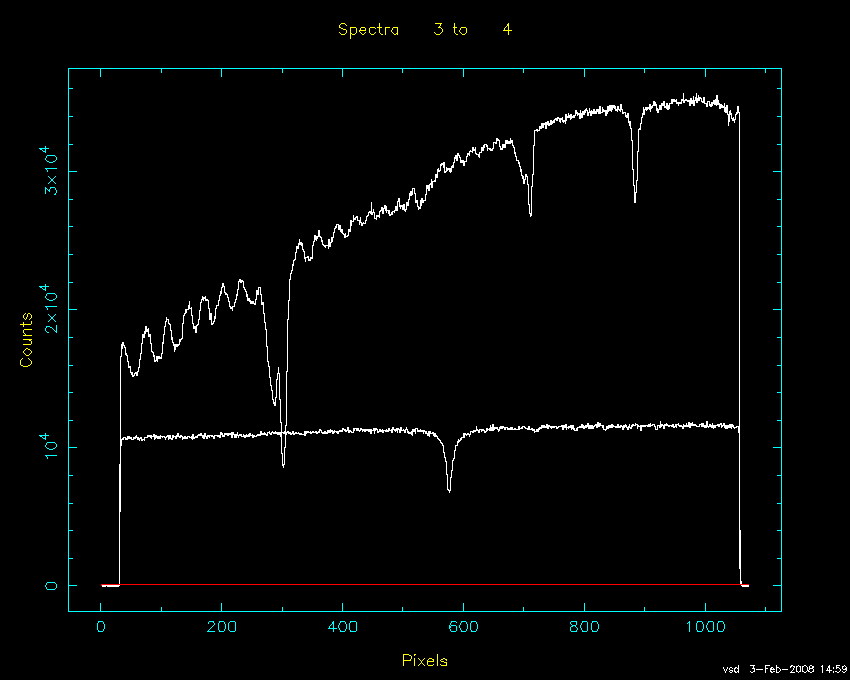
The line near the centre of the VPH 656 spectrum is Halpha. This same line
is visible at the extreme right of the grism #5 spectrum. Following the
same analysis as used for VPH 475 above, we find that the ratio of the
counts just to the right of Halpha is:
Grism #5/VPH 656 ~ 35000/12000 = 2.9
According to the EFOSC2 grisms page, the dispersion of grism #5 is
2.06 A/pixel. With ULTRASPEC's 13 micron pixels, the dispersion of
grism #5 is hence 1.79 A/pixel. The dispersion of VPH 656 is 0.48
A/pixel. Hence if the two grisms are of equal efficiency, one would
expect a ratio of counts of 1.79/0.48 = 3.7 We observe a ratio of
2.9, hence we can conclude that VPH 475 is 1.3 times more efficient
than grism #5. According to the plots on the EFOSC2 grisms page, the
efficiency of grism #5 is approximately 30% at the wavelength of
Halpha (6562 A). Hence we can conclude that the efficiency of VPH
656 is approximately 40%.
The theoretical efficiency of the grating at this wavelength is 97%, but again, this is attenuated by absorption in the prism glass, which is approximately 98% for 10mm of N-SF66. Assuming the average light ray passes through 40mm of this glass, and ignoring residual AR reflection losses, the expected grism efficiency is 0.97*0.98**4 = 89%. Hence the VPH 656 is approximately half as efficient as I would have expected.
Note that I have double checked the above numbers using different ESO grisms and different standard stars, and the results are all in agreement.
UPDATE ON 08/10/2008: I discovered from Linda Schmidtobreick (ESO) that the published ESO grism efficiencies include the whole optical path starting from the primary mirror! This is excellent news, as I was previously comparing the theoretical VPH grism efficiency with the total system efficiency, hence it is not surprising that I see a factor of two discrepancy between the two! So, it looks like our concerns over the lower than expected VPH grism efficiencies were unfounded.
The images below show some of the first arc spectra taken with the VPH 475 (top, 60s Argon arc with a 1" slit, run089 on 27/01/08) and VPH 656 (bottom, 5s Argon arc with a 1" slit, run084 on 27/01/08). Significant scattered light is present, so much so that the arc lines are barely visible in contrast. This is due to collimated light at grazing incidence scattering off the inside of the VPH grism barrels. Even though the barrels have been anodised black, the walls effectively act like a mirror, producing the approximately circular ghost near the centre of the image. Some ghosting probably also comes from scattering off the chamfered top (and bottom) lip of the grism barrel, as shown in the ESO technical drawing.
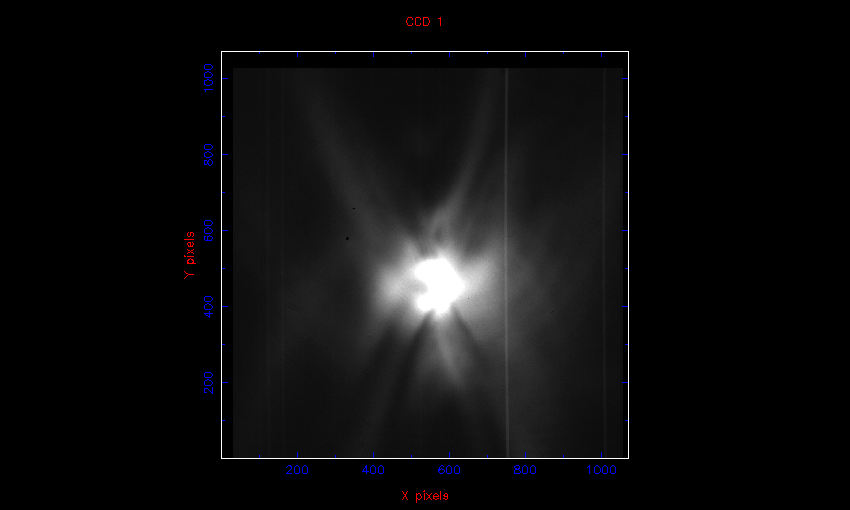

Alain Gilliotte (ESO) advised that this was a problem that had been seen before in the standard EFOSC2 grisms and was easily fixed using self-adhesive black felt. The following night, after Alain had applied felt to both VPH grisms, we took arc spectra again. The results are shown below: top, VPH 475 (run040 on 01/02/08, 100s Argon arc, 1" slit); bottom, VPH 656 (run044 on 01/02/08, 60s Argon arc, 1" slit). No residual scattered light is present, even though longer exposure times were used, indicating that the problem has been solved.
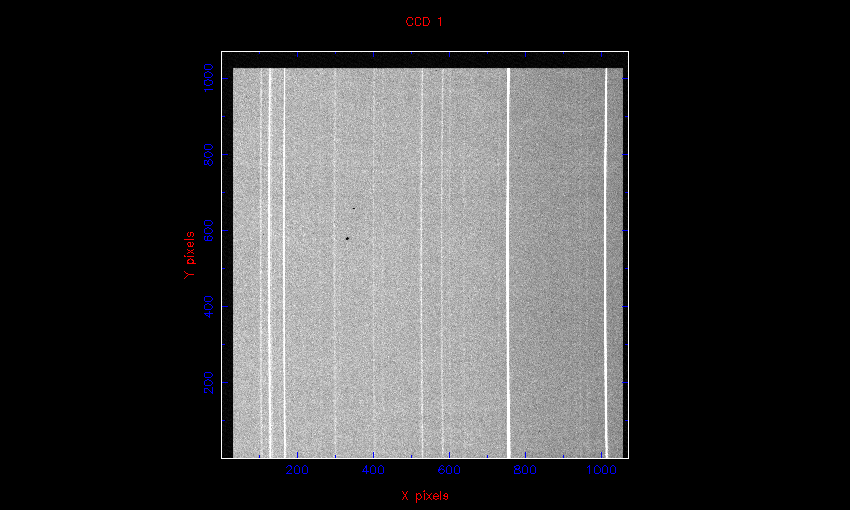
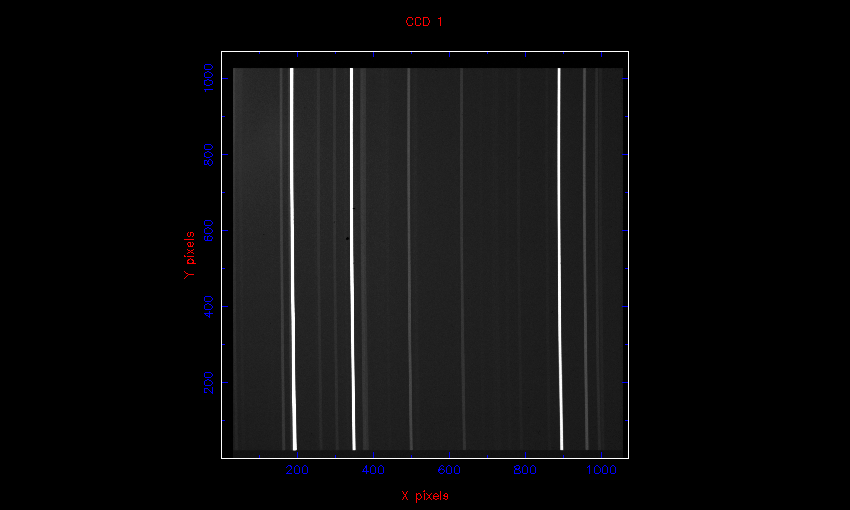
It could be said that self-adhesive felt should have been unnecessary, as the barrels could have been sand-blasted on their interior at the time of manufacture, and no chamfer should have been put on them. But we made the barrels to precisely the specification given by the technical drawing and the example sent to us, hence we did not anticipate these problems. In any case, the self-adhesive felt, as used on the ESO grisms, does a perfectly adequate job of removing the ghosting.
As a check on the scattered light, I show below quartz-lamp flat fields obtained with a 1" slit with the VPH 475 grism (top, run022 on 02/02/08, 500 sec exposure) and the VPH 656 grism (bottom, run023 on 02/02/08, 50 sec exposure), obtained after the black felt had been attached. As can be seen, there is no evidence for ghosting in the flats.
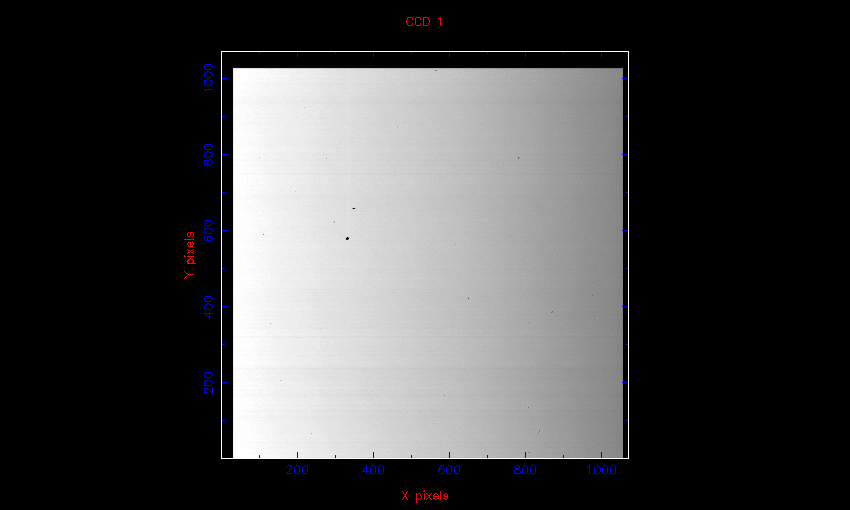
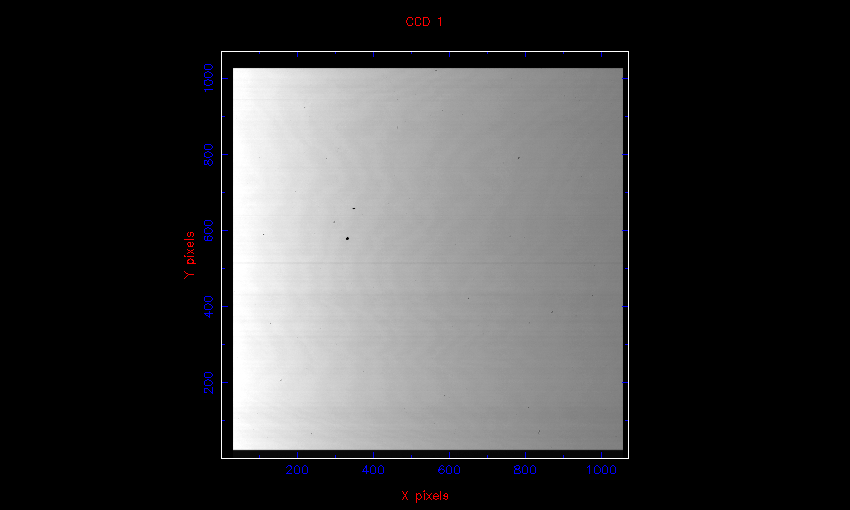
Alain Gilliotte tested the flatness of the VPH 656 grism with an interferometer at La Silla. Once defocus is taken into account, the grism is flat to lambda/5, a similar value to the standard ESO grisms. Hence he was satisfied that the optical quality was acceptable. Detailed information on these tests is available from myself or Alain. Note that Alain was unable to test the VPH 475 grism due to the unavailability of a blue laser.
The grism barrels have been anodised black and appear finished to a high quality. Their dimensions are correct, such that they fit within the slots in the EFOSC2 grism wheel and have sufficient clearance with the filter wheel above it. The silicone sealant used to mount the VPHG assembly in the barrel appears to be effective.
The x positions of one of the arc lines in the VPH 475 grism spectrum shown above are, from top to bottom, pixels 757, 754 and 757. This means that the arc line is slightly curved (by 3 pixels), with the centre of the curvature aligned with the centre of the chip. Corresponding numbers for the VPH 656 arc spectrum shown above are 348, 349 and 354. This shows that the curvature is slightly larger in the VPH 656 grism (6 pixels) and not as well aligned with the centre of the chip. It should be noted that this is not a problem that can be rectified by realigning the slit - the image of a slit in white light lies perfectly vertical, along the CCD columns. The curvature is actually due to the presence of lateral chromatism caused by the high refractive index of the prism glass. It is straight-forward to take account of during data reduction.
The spectrum of a quartz lamp taken with a pinhole mask in the slit wheel is shown in the image below: top - the VPH 475 grism (run044 on 28/01/08, 4 sec exposure); bottom - the VPH 656 grism (run055 on 28/01/08, 2 sec exposure). By measuring the y positions along the spectrum, it can be shown that both spectra are straight to better than 0.1 pixels (the accuracy of the position measurement). The fact that the spectra appear at different rows of the CCD in the two images is a problem which will be discussed in the next section.
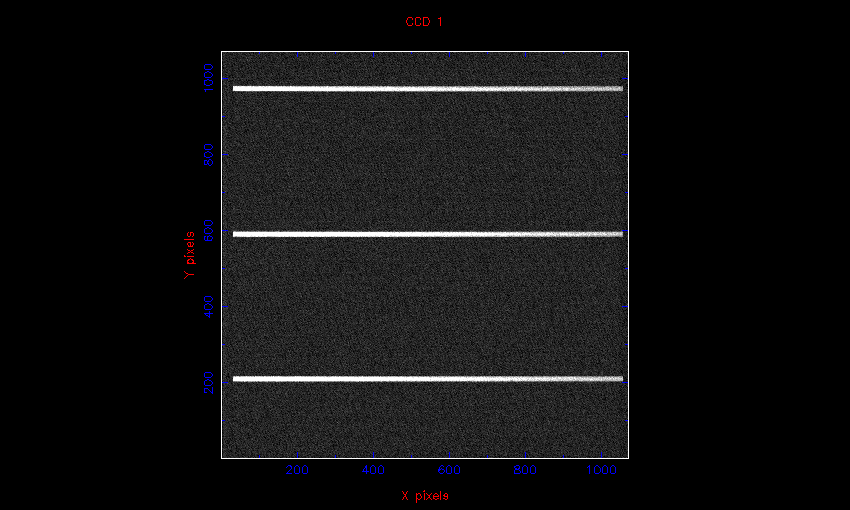
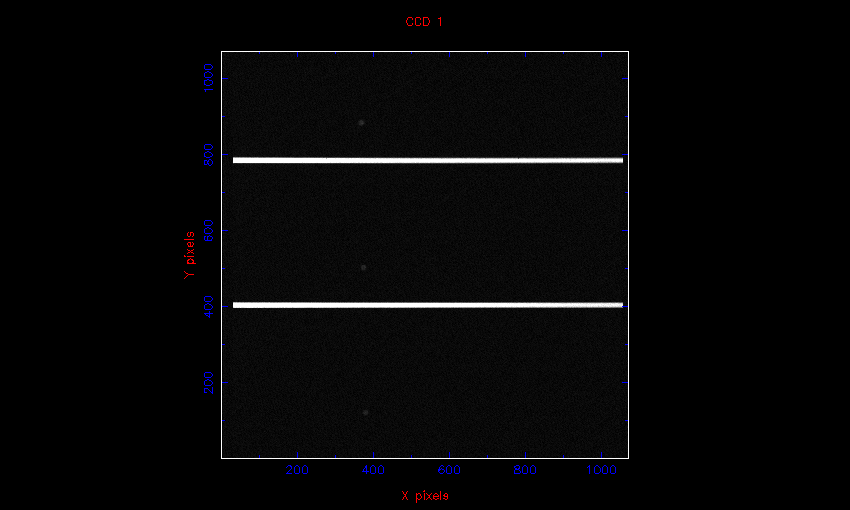
In summary, the grisms are mechanically and optically within specification, although there appears to be a problem with their alignment, as discussed next.
If a star is placed in the centre of the slit, and then one of the VPH grisms is put into the beam, the resulting spectrum does not fall on top of the image of the star. Instead, the spectrum is shifted vertically, i.e. in the spatial direction. The same effect is not seen to anything like the same extent in the standard ESO grisms. The images below demonstrate this effect. The top frame shows an acquisition image of a standard star (run078 on 28/01/08), with the 10" slit in the beam and the grism out of the beam. The middle frame (run079 on 28/01/08) shows what happens when the VPH 475 grism is put in the beam - there is a spatial shift of 471 pixels, i.e. 65 arcseconds. The bottom frame (run082 on 28/01/08) shows what happens when the VPH 656 grism is put in the beam - there is a spatial shift of 667 pixels, i.e. 92 arcseconds.
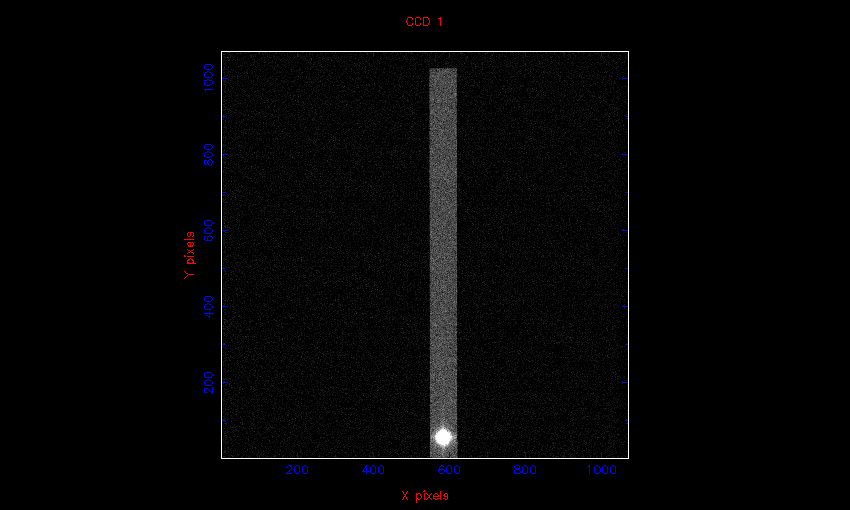
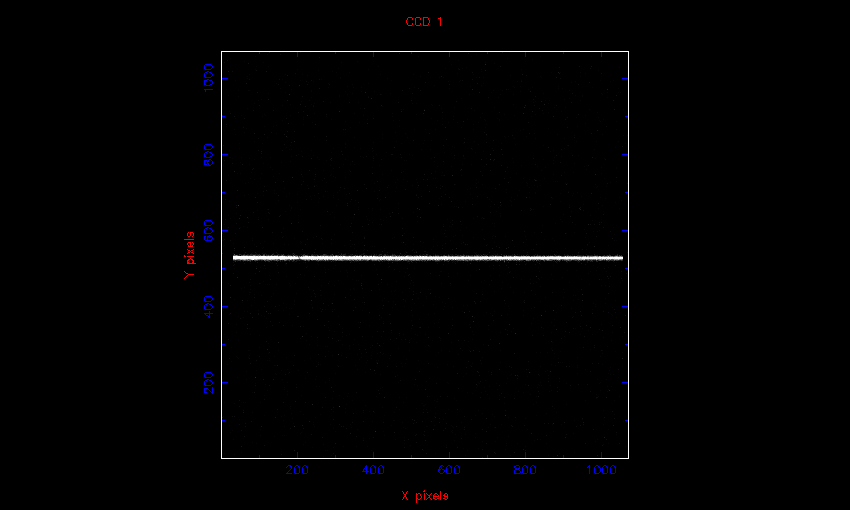
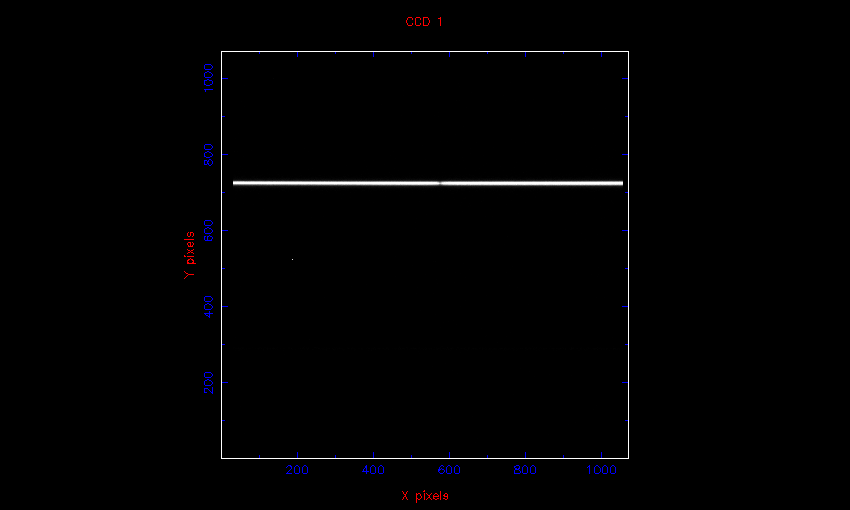
It is a simple matter to work around the above problem - acquire the object near the bottom of the slit and the spectrum will appear near the middle of the chip, as shown in the example images above. The net effect is that there is a loss of slit length of 65 and 92 arcseconds with the VPH 475 and 656 grisms, respectively. The total slit length on ULTRASPEC is 142 arcseconds, so this is not a critical problem, particularly because ULTRASPEC is primarily a point-source instrument.
The ESO CCD#40 has a slit length of 5.2 arcminutes, so the above shifts represent a loss of slit length of only 21% and 29% when using the VPH 475 and 656 grisms, respectively, with the standard ESO CCD.
Hence it can be seen that the VPH grisms substantially improve the performance of EFOSC, allowing much higher resolutions than previously available, and at a higher efficiency. We have successfully used them for the entire 17-night ULTRASPEC science run without problems, and intend to apply for more time to use them again in future periods.